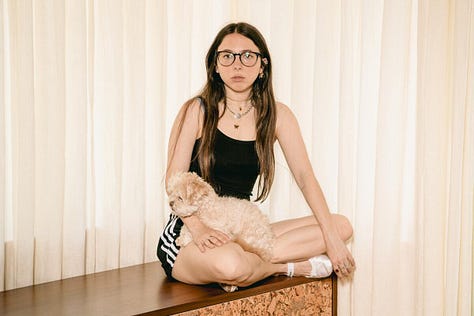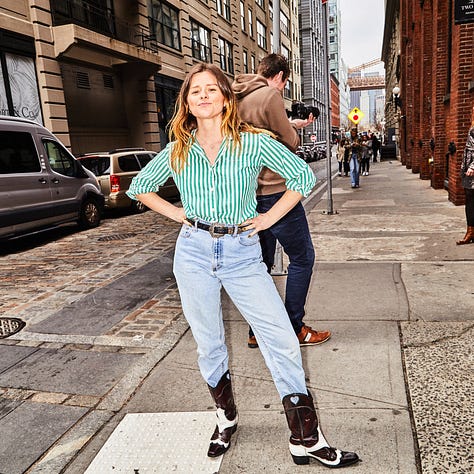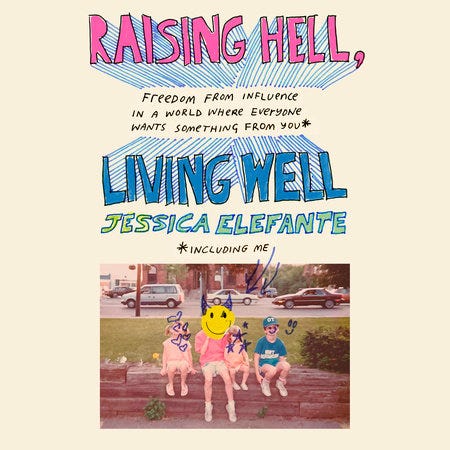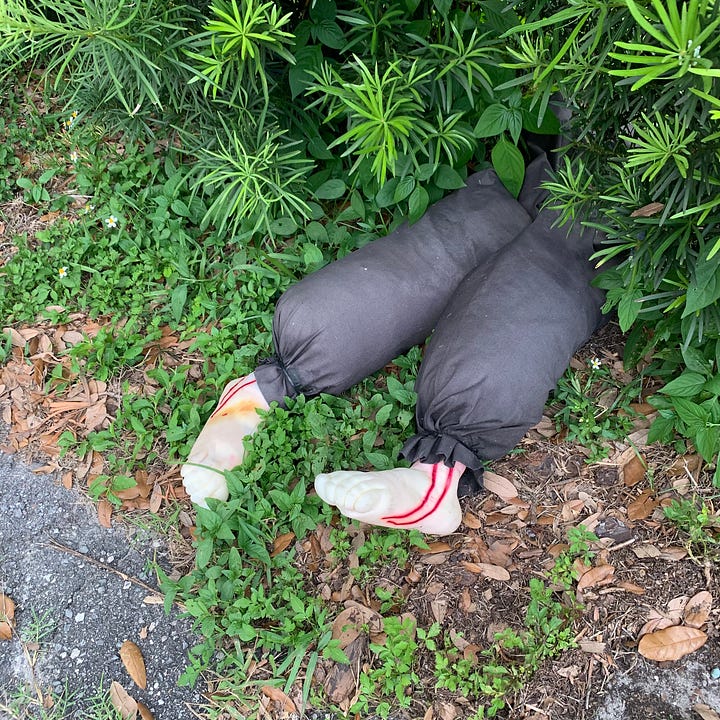#20: Forward Thinking
Topics this week (broadly defined) include the future, brands, and the future of brands
Hiii happy Saturday. I like doing these hodgepodge newsletters because I feel like I’m back in the newsroom pitching stories to an editor to gauge interest for a lengthier piece. Maybe in a future newsletter we’ll play with that concept…………
Gen Z Uses Tools Old and New, Borrowed and (LinkedIn) Blue
You can’t browse a professional site these days without being smacked in the face with a guide to managing Gen Z workers, an article about their communication style, or a weekend workshop to unpack their fears and motivations. Two items of this ilk intrigued me this week. The first, according to NY Magazine, teenagers love LinkedIn and consider it a respite from the toxicity of other social platforms. These ambitious adolescents are also keen to build their reputations by documenting academic and work achievements on the site.
The second, the advent of Irregular Hours, a “company dedicated to transforming the professional lives of Gen Zs and revolutionizing work culture.” Irregular Hours boasts a variety of really cool programming, from professional photoshoots (complete with makeup and wardrobe assistance) to breakfast networking events to a personality assessment that informs your career archetype. All free.
On one hand, I’m depressed that teens find solace in LinkedIn, a platform that sometimes favors a different flavor of vapidity and meaninglessness. On the other—as evidenced by companies like Irregular Hours—I think the behavior stems from a place of rejecting systems that do not serve their (and society’s) interests. They’re the canaries in the coal mine, calling attention to problems that their elders unknowingly perpetuate or are too tired to fix. A good reminder that youths don’t just move music, fashion, and technology forward. They’re also laying the foundation for their (and our) future of work and living. From Irregular Hours: “We encourage you to move through the world with an acute awareness of the subtle shifts and remember that today’s tremor is tomorrow’s revolution.” I hope this means I’ll eventually develop some fondness for LinkedIn.



Gatekeeping is Back, Baby
I’ve been a fan of actress/comedian Esther Povitksy (FKA Little Esther) since her Alone Together and Dollface days. During the pandemic she gained traction on TikTok as the “Jane Goodall of Hot Girls,” trendspotting (mostly) food and beauty products her hot L.A. friends were purchasing. Her most recent video began with an apology for the delayed report despite demand. “Gatekeeping is coming back and that’s why it’s been a slow season,” she says. This isn’t surprising to me!!! A few weeks ago I wrote about the proliferation of no holds barred consumption lists. We’re sharing too many secrets! The influencing bubble is fit to pop. Classes in influencing are entering university course catalogs.1 A friend of mine conducts alumni admissions interviews and he told me that of the twenty students he’s chatted with, all but a handful have career aspirations of influencing. If everyone wants to be an influencer and we’re all watching, buying, wearing, and eating the same things,2 what is left to promote and who is left to influence?
Enter the post-influencing era. Ex-influencer Lee Tilghman is the poster child for the movement; she gave up a $300k annual salary shilling wellness products to reconnect with her offline self in 2019. Reformed “bullshit artist” Jessica Elefante’s book “Raising Hell, Living Well: Freedom from Influence in a World Where Everyone Wants Something from You” is out this Tuesday (I can’t wait to read). Content creators lament the online personas they’ve built entire careers upon and don’t know how to frame that offline evolution to their audience and sponsors.3 I wonder how or if aspiring influencers will heed these warnings. Marketers say micro-influencing is the next big thing, as if these concerns only accompany scale. We’ll see.



Seemingly Relatable!
I’m just as fatigued by the Taylor Swift/Travis Kelce news cycle as the rest of you, so humor me as I call out a tangentially related think-piece that missed the mark this week. For Puck, Lauren Sherman wondered why, given Swift’s influence in the culture, does she not collaborate with a major fashion house? She settles on two conclusions: one, fashion isn’t in her wheelhouse and she doesn’t need the money or exposure LVMH or Gucci or whoever would offer. Two, she’s so forward thinking that she might be saving her influence for her own brand launch.
Let’s explore a third explanation and a take I haven’t seen yet. Swift has built a powerful brand on being relatable. A girl of the people, a girl who posts videos of her cats, a girl who over-analyzes conversations with her boyfriend. By every other metric Swift is untouchable. At the end of 2024, she will be a billionaire—a term her demographic typically reserves for tech psychopaths and greedy financiers. She’s teetering towards inaccessibility. How is she controlling for this variable? She’s reaffirming her girl-next-door brand, getting a little tipsy cheering on her All American footballer boyfriend, coloring her tresses an unassuming, natural shade of dirty blonde, wearing clothes from Free People and Reformation (brands whose price points hover around $200-400, not $2000-$4000). Even though her face is plastered on television screens and NFL socials, her audience still views her as their cool, wise older sister, babysitter, or sorority president who just happens to be famous. Clothes play an important role in that perception. She may carry a Louis Vuitton Camera Box bag, yet note (a) how frequently she’s worn and (b) how pals Blake Lively and Sophie Turner also sported in pap shots this month. Outfit repeating and sharing your wardrobe with friends and roommates….. relatable.
RIP Excellent Brands, Mediocre Products
I enjoyed this Fast Company breakdown of once darling DTC (direct-to-consumer) brands’ descent into zombie state i.e. treading water until acquisition. The article comes after an abundance of Glossier coverage last month following the release of Marisa Meltzer’s behind-the-business book. We’re almost ten years out from the digital-first beauty brand’s launch, spurring conversation around the future of DTC brands. Without the once bulletproof tactic of social media advertising (now oversaturated and costly) brick and mortar is working for some, acquisition for others.
When assessing these DTCs my mind goes to the question, is this a durable product, a durable brand, or both (the platonic ideal)? We as consumers all knew the importance of branding pre-Instagram, but I’m suspicious that the ease of branding ourselves online resulted in some founders’ false confidence that they could develop a commercial brand first and a product later. All flash, no substance. Most DTC brands that are thriving today are ones that have proprietary processes or genuinely innovative, life-changing products. Certainly not the case for every company, but when I think of my Allbirds gathering dust in the closet and my Haloscopes collecting bacteria under the sink, I’m forced to contend with the fact that those products are just OK. I bought them because of the buzz. I bought them because it’s fun to be the first one in the friend group to try something. I bought them because of the BRAND.4
Sidewalk Reporting


I’m delighted to report that Halloween decor is popping around the neighborhood. I might try to scrounge up a report about the psychographics of holiday home decor (I hope this exists??) because the polarity of decor approaches—Image 1 vs Image 2— is FASCINATING.
Thanks for reading! I hope you have fun Saturday night plans. I’m watching the Beckham documentary and eating my beloved Goodles :)
A less critical view of this is that marketing professors are simply repositioning their courses with language students immediately understand and find value in
Because !!!Flattening Tastes!!!
Couldn’t resist another self citation here. I touched on this unsettling blurring of offline and online personalities here
FWIW, I’m consistently impressed by Tower28, a beauty brand anchored by a mission to make sensitive skin products effective and fun. With each new product launch I fall more in love with the brand





